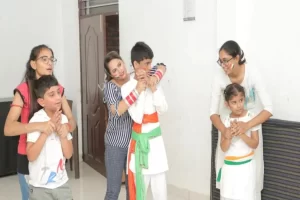
Source: ctfassest
Dyslexia is a learning disability that impacts an individual’s capability to read, spell, write, and express. It is about how the brain processes the language.
Defining Dyslexia as a Learning Disability is important in being considerate that those with dyslexia learn differently from others, and with the right help and support, can attain academic success.
Types of dyslexia as a learning disability with its sole challenges:
- Phonological Dyslexia: Children struggle to break down words into smaller units, which makes it difficult for them to associate sounds with their matching letters.
- Surface Dyslexia: Children with Dyslexia as a Learning Disability encounter difficulties in identifying words by vision, prominent to difficulties with reading smoothly.
- Rapid Naming Deficit: Challenges in rapidly naming letters, numbers, or colors, impacting reading speed and understanding.
By Defining Dyslexia as a Learning Disability, we recognize its difficulties and the significance of tailored educational tactics. Considering dyslexia is the first step in making an in-depth learning setting where every individual’s learning wants are met.
What are Different ways to Teach Dyslexic Students?
There are different ways to teach dyslexic students efficiently it requires an understanding of their unique learning needs and adjusting teaching methods accordingly. One of the most effective ways to explain dyslexic students is through a multi-sensory aspect. This method hits into the numerous learning styles—visual, auditory, hands-on, and real—to increase understanding and remembering.
Here are some different ways to teach Dyslexic students:
Visual Learning
The use of charts, graphs, and visual means can help in picturing concepts. Color-coding various parts of speech in sentences or steps in a math problem can help to learn more openly.
Auditory Learning
Including auditory elements like verbal instructions, discussions, or audio recordings can help those who learn better through listening. Repeating information and using prompt devices can also be helpful.
Kinesthetic Learning
Hands-on activities, experiments, and the use of physical objects can help practical students understand intellectual concepts. Tactile activities like forming letters in the air or walking out math difficulties can be mainly effective.
Tactile Learning
Tactile students take advantage of touching and operating objects. Using textured paper for writing, or building models for science and math concepts can enhance their learning experience.
Including these techniques in the means of teaching dyslexic students makes sure that learning is interactive and effective. Another critical approach in the means to teaching dyslexic students is the use of organized learning programs. These programs are clear, and orderly, and begin with the simplest concepts, slowly moving to more complex ones. This structured approach goes well with the needs of students with dyslexia.
Defining dyslexia as a learning disability helps in making these teaching methods suit the individual needs of each student. By understanding and defining dyslexia as a learning disability obviously, educators and parents can better provide themselves with the appropriate tactics and tools. Technology plays an important role in the means to explain dyslexic students. Tools like text-to-speech and speech-to-text software, audiobooks, and educational apps can offer essential support to get rid of learning barriers.
To join Vidhyanidhi’s Learning Disability Courses, call on +919321024137 / +9198698662
To download the brochure, of course, click here!

Source: brainbalancecentres
What are the Problems faced by Dyslexic Students in Classroom?
Dyslexia, a common learning problem, influences various students across several educational environments. The primary characteristic of dyslexia as a learning disability includes problems with reading, writing, and spelling, but its choice spreads much further, moving the student’s all-round classroom experience.
Here are some of the problems faced by dyslexic students in classroom, emphasizing areas such as writing, spelling, planning, organizing, and expressing information:
Defining Dyslexia as a Learning Disability
- Dyslexia as a learning disability primarily affects the capabilities involved in precise and easy word reading and spelling.
- Considered by problems in phonological awareness, verbal memory, and verbal processing speed.
- Dyslexia is a variety, meaning symptoms can be different in severity from person to person.
Problems Faced by Dyslexic Students in Classroom
Difficulties in Writing and Spelling
- Dyslexic students often face problems with identifying sounds in words, making spelling an essential challenge.
- This problem goes up to writing, where incorrect spellings can interrupt the flow of ideas.
- The problems faced by dyslexic students in the classroom are worsened by the stress and frustration caused by these spelling errors.
Planning and Structuring Work
- Shaping views logically can be an obstacle, leading to difficulties in planning essays or projects.
- The lined structure of most academic work makes a difference in the dyslexic student’s usually non-linear thinking process.
- This approach of defining dyslexia as a learning disability results in their ability to start and effectively structure their work.
Organizing Information
- Dyslexic students may find it hard to sequence information logically, a key aspect of learning.
- Difficult faced by dyslexic students in the classroom involves arrangement and prioritizing information.
- Remembering sequences or following multi-step instructions can also be problematic.
Expressing Knowledge
- Despite having a good understanding of the subject matter, dyslexic students might struggle to express this knowledge through conventional testing and written assignments.
- Oral exams and presentations might also pose a challenge due to issues with word retrieval and verbal expression.
- These problems often cover the student’s true knowledge and can affect their academic performance.
Understanding and knowing the problems faced by dyslexic students in classroom is essential for educators and peers. By defining dyslexia as a learning disability not just as a problem but as a different way of processing information, we can begin to explore more inclusive teaching methods and supportive tactics. Awareness and appropriate support can importantly enhance the learning experience and academic success of students with dyslexia as a learning disability.
To join Vidhyanidhi’s Dyslexia as a Learning Disability Courses, call on +919321024137 / +919869866277.
To download the brochure, of course, click here!

Source: english
What are the methods of Dealing with Dyslexia in the Classroom?
Dyslexia, a common learning problem affecting reading, writing, and spelling, gives unique challenges in the educational environment. Considering and effectively dealing with dyslexia in the classroom is important for developing an in-depth and supportive learning setting. This article teaches the methods of Dealing with Dyslexia in the Classroom that educators can implement to guide students with dyslexia, focusing on the significance of optimism and availability in teaching tactics.
Look for Positives
- Recognizing Achievements: To build confidence among children, appreciate their small achievements, and encourage them to do more.
- Positive Reinforcement: Using verbal praise and rewards by acknowledging the progress will have a positive impact on children.
- Uplift Strengths: Identify and nurture the individual strengths of each student.
Seamless Transitions between Activities
- Clear Instructions: Provide straightforward, step-by-step directions for transitioning.
- Visual Schedules: Use visual timetables to make upcoming activities predictable.
- Consistent Routines: Establish regular patterns to reduce anxiety and confusion.
Chunk Tasks to Support Working Memory
- Break down Assignments: Divide larger tasks into manageable segments.
- Step-by-Step Approach: Offer instructions in small, sequential steps.
- Regular Breaks: Allow time for rest to prevent cognitive overload.
Provide Visual Aids
- Use of Graphics and Charts: Incorporate visual learning tools to complement text.
- Colour Coding: Utilize colors to differentiate and organize information.
- Mind Maps: Help students visualize concepts and relationships between ideas.
Provide Lesson Summaries
- End-of-Lesson Recaps: Summarize key points at the end of each session.
- Written Summaries: Offer written outlines for students to review at home.
- Multimedia Resources: Use videos or audio recordings as supplementary materials.
Effective Communication with Parents
- Regular Updates: Keep parents informed about their child’s progress and challenges.
- Collaborative Strategies: Work together to reinforce learning strategies at home.
- Resource Sharing: Provide parents with materials and resources to support learning.
Dealing with dyslexia as a learning disability in the classroom strains a blend of tolerance, understanding, and imagination. By emphasizing positive support, making sure of smooth changes, breaking tasks, providing visual aids, and to-the-point lessons, and maintaining open communication with parents, educators can create a nurturing environment that provides the varied needs of students with dyslexia. These are the methods of dealing with Dyslexia in the classroom that not only be used in managing dyslexia but also contribute to a more dynamic and in-depth educational experience for all students.
To join Vidhyanidhi’s Learning Disability Courses, call on +919321024137 / +919869866277.
To download the brochure, of course, click here!

Source: english
Which is Best Dyslexia Professional Development Course?
The importance of specialized training, specifically in the field of learning problems, cannot be overstated. Among the countless options available, the best Dyslexia Professional Development Course provided by Vidhyanidhi Education Society (Govt. regd.) is an example of fineness. This course is made for educators, parents, and professionals wanting to increase their understanding and abilities in supporting individuals with dyslexia.
Globally Recognized Certification
The Dyslexia Professional Development Course provides a certificate that is esteemed and recognized worldwide. This response makes sure that the qualifications you take are not only valuable but also universally accepted.
Flexible Learning Modes
Understanding the varying needs of learners, the course offers the convenience of online and distance learning modes. This flexibility is provided to those who prefer to set their own pace of learning or have other commitments, enabling them to balance their professional development with personal responsibilities.
Focused Assessment Method
The course employs a straightforward assessment approach, relying solely on MCQ-based online assessments. This technique shortens the evaluation process, making it more available and less time-consuming for members.
Internship Opportunities
Participants are supported with a reference letter for internship purposes. This aspect enables hands-on experience, letting learners apply theoretical knowledge in real-world settings.
Cost-Effective with Simple Content
The course is not only affordable but also presents its content in a clear and comprehensible manner. This approach ensures that learners can easily grasp and apply the concepts of the best dyslexia professional development course.
Expertly Crafted Course Material
The course content is meticulously developed and periodically reviewed by licensed practitioners. This assures that the information is both current and clinically accepted, increasing the all-round learning experience.
Guidance from Seasoned Mentors
Throughout the dyslexia professional development journey, learners receive guidance from experienced mentors. These experts bring valuable visions and real wisdom, inspiring the learning process.
Certificate without Mode Mention
Unique to this program, the term “Online Mode of study” is not mentioned on the certificate, ensuring that the mode of learning does not overshadow the achievement and knowledge gained.
Defining Dyslexia as a learning disability and its Implications in Education
Learning problem, affecting reading, writing, and spelling abilities is known as Dyslexia. Teachers and experts need to know its problems to give effective help and support. The Dyslexia Professional Development Course at Vidhyanidhi Education Society (Govt. regd.) provides participants with the essential tools and tactics to support individuals with dyslexia. Understanding dyslexia is not just about identifying the difficulties it has but also about appreciating the unique viewpoints and abilities of those who experience it.
The best Dyslexia Professional Development Course provided by Vidhyanidhi Education Society (Govt. regd.) is an ideal program, mixing affordability with high-quality, hands-on content, and expert guidance. It stands as an essential resource for those who are keen to make a significant impact in the lives of individuals with dyslexia. By contributing to this course, you gain not only knowledge and skills but also join a community dedicated to optimistic change in the field of learning difficulties.
Join Vidhyanidhi’s Dyslexia Course – Transform Lives & Your Career!
To join Vidhyanidhi’s Learning Disability Courses, call on +919321024137 / +919869866277.
To download the brochure, of course, click here!
FAQs
Is Teacher Training for Dyslexia included in any course?
Yes, some courses involve Teacher Training for Dyslexia, focusing on specialized teaching tactics for dyslexic students.
How do I become a Dyslexia Tutor?
By pursuing a course in Special Education along with gaining experience some experience can help you become a Dyslexia Tutor.
What is Dyslexic Learner Definition?
A learning condition impacting the reading, writing, and spelling abilities of the children is the Dyslexic Learner definition.



